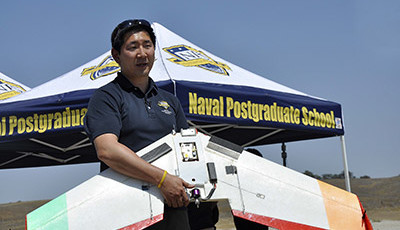If you think one drone with rockets is scary…
September 02, 2015
on
on

Drones are generally solitary craft, a single UAV flying alone controlled by an operator miles away. Be afraid, stand by for the swarm… recent trials showed that two swarms of 25 UAV’s flying with built-in autonomous flying control systems were able to be controlled by just one operator per swarm.
Assistant Professor Timothy Chung of the Naval Postgraduate School (NPS) and members of NPS' Advanced Robotic Systems Engineering Laboratory (ARSENL) flew 50 autonomous UAVs breaking their previous record of 30, set just five weeks ago. The UAVs performed basic leader-follower cooperative behaviors and exchanged information amongst themselves via wireless links.
"This project came from the notion that quantity is a quality (i.e. emergence)," said Chung. "It's like trying to play a game of tennis against an entire 5th grade class. If they were all lobbing tennis balls across the court, it would be very hard (for a single person) to defend against them. One of the ways we can mitigate that is transferring autonomy. These robots can make limited decisions ... that will alleviate some of the pressure on our human operators".
NPS Consortium for Robotics and Unmanned Systems Education and Research (CRUSER) Director Raymond R. Buettner pointed out some of the more benign and beneficial applications of the technology, "Twenty years from now aerial swarms will be routinely helping farmers improve their crops and help locate lost children”. He forgot to mention en masse pizza delivery at house parties.
Assistant Professor Timothy Chung of the Naval Postgraduate School (NPS) and members of NPS' Advanced Robotic Systems Engineering Laboratory (ARSENL) flew 50 autonomous UAVs breaking their previous record of 30, set just five weeks ago. The UAVs performed basic leader-follower cooperative behaviors and exchanged information amongst themselves via wireless links.
"This project came from the notion that quantity is a quality (i.e. emergence)," said Chung. "It's like trying to play a game of tennis against an entire 5th grade class. If they were all lobbing tennis balls across the court, it would be very hard (for a single person) to defend against them. One of the ways we can mitigate that is transferring autonomy. These robots can make limited decisions ... that will alleviate some of the pressure on our human operators".
NPS Consortium for Robotics and Unmanned Systems Education and Research (CRUSER) Director Raymond R. Buettner pointed out some of the more benign and beneficial applications of the technology, "Twenty years from now aerial swarms will be routinely helping farmers improve their crops and help locate lost children”. He forgot to mention en masse pizza delivery at house parties.
Read full article
Hide full article


Discussion (2 comments)